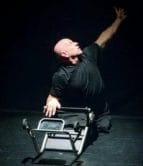Editor’s Note: This is part of Picture this Post's series - CHOREOGRAPHERS' EYES - DANCERS EXPLAIN DANCE. Find more here.
Ayako Kato on Pritzker Pavilion Stage
Against the white noise of downtown Chicago, both audible and visible within the enclosed Jay Pritzker Pavilion Stage, an eager audience flanked the floor-level stage on three sides. The fourth perimeter of the stage an expansive wall of windows, serving as both backdrop and living scene to Ayako Kato’s world premiere performance, “blue fish”, April 21 and 22, 2017. This intimate, distinctively unique setting served to heighten the beauty and pleasure of Kato’s avant-garde choreography and staging.
The show opened with Kato’s surreptitious appearance. Abruptly and seemingly from nowhere, Kato’s measured presence materialized on stage as if she had always been there. Lighting designer Richard Norwood expertly combined light he controlled with that of the windows and darkening night sky, wonderfully ushering in transitions and tone. A dark floor with Kato’s dark clothing blurred the boundaries between performer and environment, while staged objects were juxtaposed against the darkness. The experience was multisensory, the aesthetic distinctive.
Water
Round, white paper sculptures of various sizes randomly outlined and embarked upon the stage floor; later they glowed with light. A long red bamboo pole was gently lifted with a single point of contact, divided into 3 sections and tossed aside. Yet, for a graceful moment a fisherman adroitly wielded the pole. A clear plastic bottle of water plucked from the stage floor tossed into the air and caught. Opening the water bottle she hesitated before drinking, paused, looked to the potted tree on stage; the tree received water first, then she. A show of strength unfolded into militaristic-like action, a sword, a march, stomping feet, a soldier. “Boys should be ambitious”, is stridently exclaimed. Then, just above a whisper, “What about the girls?” Throughout the performance Kato applied every aspect of herself and body with expressive and remarkable form.
Rebirth
One of Kato’s most impressive passages and visual enchantments expressed rebirth. Like physical poetry she fluidly transformed into a cocoon, over the sound of waves crashing against a shore. From the cocoon, a newborn being emerged and began to explore and discover itself in parts; hands, legs, feet, arms rolled and writhed into view and into consciousness. Waves crashed more violently, and with conviction, as the new being evolved with a subtle underlying intensity rendered by the interconnected sound and Kato’s organic movements.
Audience Participation
The most unique and unexpectedly enjoyable segment of the show was when the audience was shown a rhythmic dance sequence and invited on stage to participate. The invitation drew nearly half of the audience members. The group formed a circle, learned the dance sequence, and then performed in unison. It was quirky, yet beautiful and evoked another instance of anonymous parts coming together, functioning together, and forming a whole.
Fearless Experimentation
This performance is a significant experimental work, with tones ranging from modern and improvisational to ancient and precise. “blue fish” is the essence of life, of engagement and understanding, of living organisms anonymous, possibly insignificant alone, but potentially germane to nature and the world as a whole. Themes of water, elementary to life, and individual parts forming a whole, question our role as human beings. Ayako Kato’s “blue fish” is fearless in its inherent and extrinsic exploration of self. “blue fish” is truly something special.
To find out more about Ayako Kato’s pioneering choreography visit the Art Union Humanscape website. You can also read more about Ayako Kato’s philosophy reflected in her reviews of dance performances in Picture This Post.
Look for a review by choreographer Sara Maslanka on these pages of Ayako Kato’s What Is Movement?, a dance-based inquiry into movement and stillness, that will be part of the 5th Annual Pivot Arts Festival.
Photos: William Frederking
Editor’s Note: This is part of Picture this Post's series - CHOREOGRAPHERS' EYES - DANCERS EXPLAIN DANCE. Find more here.
Learn more about dance by seeing dance through dancers eyes in the Picture This Post series, “Choreographers’ Eyes - Dancers Explain Dance”. Watch this video preview of the story here—
Find more Picture This Post dance reviews in the latest roundup — CHOREOGRAPHERS WE LOVE. Also, watch a short preview video here —
About the Author - Kris Lenzo:
About the Author - Sheri Lenzo:
 Sheri Lenzo credits the art of dance with offering endless unique, diverse, and unexpected movement possibilities that bridge social and physical boundaries, empowering expression through any form and magnitude of motion. A physical therapist that has worked with infants and children for the past 30 years, she has a sound background in developmental movement and neurological patterns of movement. She also has an MS in Disability and Human Development, and has consulted with MOMENTA for their Every Body Can Dance, mixed-abilities integrated dance workshops.
Sheri Lenzo credits the art of dance with offering endless unique, diverse, and unexpected movement possibilities that bridge social and physical boundaries, empowering expression through any form and magnitude of motion. A physical therapist that has worked with infants and children for the past 30 years, she has a sound background in developmental movement and neurological patterns of movement. She also has an MS in Disability and Human Development, and has consulted with MOMENTA for their Every Body Can Dance, mixed-abilities integrated dance workshops.Save
































 After losing his legs in a work accident at age 19, Kris Lenzo became a national champion in wheelchair track and wheelchair basketball. In 2003, Kris began dancing with
After losing his legs in a work accident at age 19, Kris Lenzo became a national champion in wheelchair track and wheelchair basketball. In 2003, Kris began dancing with 
